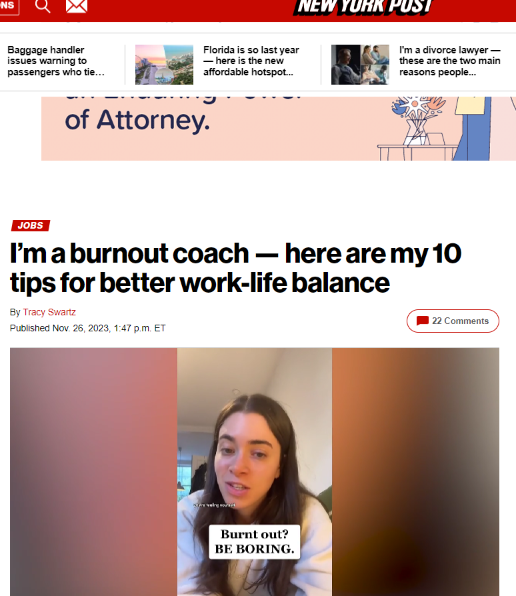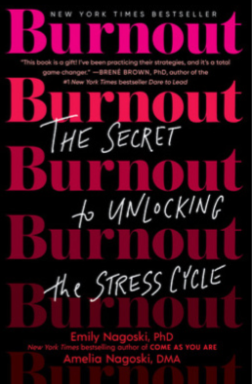The Burnout Coaching Revolution
Charlotte Jacobs, Contributing Writer
Burnout coaching is a new term to have entered the workplace lexicon as burnout becomes an increasingly significant issue for workers – including high-stressed lawyers and workers tat every level of the workplace.
Burnout affects many people today, affecting their emotional, physical, and mental well-being in a multitude of ways and dealing with the issue has become a key factor for many employers.
Burnout coaching can provide essential support, helping individuals manage and prevent burnout effectively.
By working with a specialized coach, individuals can tackle the root causes of their burnout and learn practical techniques to improve their work-life balance.
A burnout coach focuses on various strategies, including mindfulness, resilience-building, and lifestyle changes, to help clients recover and build resilience.

Many coaches, like those at Lori Prutsman (pictured)and Maggie Supernova, offer personalized programs that address specific needs and challenges for burnout.
As burnout coaching becomes more mainstream, it offers a valuable resource for anyone looking to improve their quality of life, as evidenced by the resources at Defeat Burnout.
Defining Burnout
Burnout occurs when prolonged stress leads to emotional, physical, and mental exhaustion and is an almost daily news item for lawyers and other professionals.
It often results from overwhelming workloads, lack of control, or unclear job expectations. Individuals feel drained, unmotivated, and unable to meet constant demands. Recognizing burnout is essential for implementing strategies to prevent it and maintain well-being.
Causes of Burnout
Burnout can stem from various factors. High workloads, tight deadlines, and job insecurity are common workplace triggers. Lack of support from supervisors or colleagues can also contribute.
Additionally, personal factors like work-life imbalance or perfectionism may increase the risk of burnout. Understanding these causes is crucial for developing effective preventive measures.
Burnout Symptoms and Signs
Burnout symptoms vary but commonly include chronic fatigue, insomnia, and decreased performance.
Emotional signs may involve feelings of cynicism, detachment, and irritability.
Physical symptoms can include headaches or stomach issues. Recognizing these symptoms early can help individuals seek timely intervention and support.
Burnout in Different Professions
Burnout affects different people differently and it also affects different professions in different ways.
Burnout coaching is designed to help individuals recognize and address burnout symptoms helping to support those who are needing to manage stress and achieve a healthier work-life balance.
We recently reported the tragic case of a lawyer in the UK who died after working in a high stress situation and how her law firm was taking specific ‘burnout advice’ regarding high stress issues in the firm.
And there are many cases involving mental health and burnout issues in the law profession.
And we have reported on ABA and other surveys into mental health issues in the law.
Healthcare workers often face high stress due to continuous patient care and emotional demands.
Teachers may experience burnout from managing classrooms and meeting educational standards.
Corporate employees might struggle with long hours, high expectations, and limited relaxation time.
Each profession requires tailored strategies to address specific burnout challenges effectively.
Arise The Burnout Coach
A burnout coach plays a critical role in identifying early signs of burnout and they are increasingly part of the workplace landscape as burnout becomes an ever-more prevalent issue across the board.

The burnout signs may include a drop in performance, lack of motivation, and frequent fatigue. The coach uses various strategies to help clients manage and prevent burnout.
The coach offers personalized support and guidance. They approach each client with sensitivity and empathy, creating a safe space for open discussions. They also provide tools and techniques to improve emotional, physical, and mental well-being.
By offering this support, a burnout coach helps clients regain control and improve their quality of life.
Goals of Burnout Coaching
The primary goal of burnout coaching is to help clients manage stress effectively. This involves teaching relaxation techniques and mindfulness practices. Clients learn to set realistic goals for both personal and professional life.
Another key goal is to enhance work-life balance. Coaches work with clients to identify priorities and make necessary adjustments. This helps clients allocate time for rest, exercise, and hobbies.
Achieving these goals can lead to increased job satisfaction, improved performance, and overall well-being. Effective burnout coaching focuses on long-term solutions that foster resilience and a sustainable lifestyle.
Strategies for Burnout Prevention
Burnout prevention requires a mix of creating a balanced work-life dynamic, managing stress efficiently, and honing time management skills.
These strategies help individuals maintain their mental and physical health while boosting job satisfaction.

We identifed some of the ways in which burnout can be managed n a recent article form a senor big law firm lawyer Ben Savoie (pictured) who had encountered serious mental health and pressure issues in his life.
He had some key advce for avoiding burnout, some of which are outlined here :
Creating Work-Life Balance To Avoid Burnout
Work-life balance involves ensuring that both work and personal life receive adequate time and attention. To achieve this:
- Setting boundaries: Clearly define work hours and stick to them.
- Prioritize self-care: Schedule regular breaks and downtime.
- Delegate tasks: Don’t hesitate to share responsibilities at work and home.
- Flexibility: Utilize flexible work arrangements when possible.
Building a strong support system both at work and home can also help maintain this balance, leading to improved overall well-being.
Firms and companies are increasingly aware of the need for these matters to be prioritized to assist in mental health management and to avoid burnout.
But what can be done to actually manage stress and pressure in the workplace?
Stress Management Techniques
Key stress release methods include:
- Mindfulness and meditation: Regular practice can reduce stress and increase focus.
- Physical activity: Exercise helps to alleviate stress and improve mood.
- Healthy eating: A balanced diet can have a positive impact on stress levels.
- Professional support: Therapists or coaches can offer strategies tailored to individual needs.
- Time Management: Prioritize tasks. Use tools like the Eisenhower Matrix to identify and focus on important tasks.
Incorporating these practices into daily routines can significantly lower stress levels, making it easier to handle work-related challenges. Set realistic deadlines and break large projects not manageable chunks.
Cognitive Behavioral Approaches
Cognitive-behavioral techniques are essential in burnout coaching. Coaches use these methods to help clients recognize negative thought patterns and replace them with positive ones. This approach aims to reduce stress by changing how clients think about their challenges.
Techniques like journaling and thought records are common. Clients write down their stressful thoughts and identify distortions. They then reframe these thoughts into more realistic and positive perspectives.
Role-playing and scenario analysis are also used. Through these exercises, clients explore how different responses to stress can lead to better outcomes. This hands-on approach provides practical strategies clients can use in daily life.
Mindfulness and Relaxation
Mindfulness and relaxation techniques play a vital role in managing burnout. Coaches often teach practices like meditation, deep breathing, and progressive muscle relaxation.
Mindfulness meditation helps clients focus on the present moment. This practice reduces anxiety about the future and regrets about the past. Clients learn to observe their thoughts without judgment, which can lower stress levels.
Deep breathing exercises are another fundamental tool. Techniques such as diaphragmatic breathing help activate the body’s relaxation response. This method is quick to learn and can be used anytime stress arises.
Resilience Building
Building resilience is key to preventing future burnout. Burnout coaches work with clients to develop skills that help them bounce back from stress more effectively.
One strategy is to set realistic goals. Coaches assist clients in breaking down large tasks into manageable steps. This reduces the feeling of being overwhelmed and increases a sense of accomplishment.
Social support systems are also emphasized. Coaches encourage clients to identify and cultivate relationships that provide emotional support. Having a strong network helps buffer against stressors.
Lastly, self-care routines are vital. Coaches help clients create a balanced lifestyle that includes hobbies, regular exercise, and adequate sleep. These activities nurture one’s well-being and build strength to face future challenges.
For more details on the techniques mentioned, visit Burnout Coaching Techniques.
Assessment and Identification
The first step is to accurately assess and identify signs of burnout in individuals. This begins with gathering detailed information about the client’s work environment, personal life, and stressors. Tools such as questionnaires, interviews, and self-assessment surveys help in detecting burnout symptoms like emotional exhaustion, detachment, and decreased performance.
Using these tools, coaches can pinpoint specific areas where clients need support. Effective assessment also involves understanding the client’s physical health, mental well-being, and work-life balance. This comprehensive approach ensures that no aspect of their burnout is overlooked, paving the way for a tailored coaching strategy.
Developing a Coaching Plan
Once burnout is identified, the next step is developing a customized coaching plan. This plan includes setting achievable goals, establishing regular sessions, and defining clear, actionable steps. It is essential to incorporate a mix of techniques, such as stress management, time management, and mindfulness practices, tailored to the client’s needs.
Moreover, integrating resources like the Advanced Burnout Coach Certification program can enhance the effectiveness of the coaching plan used by employers.
And the Maslach Burnout Inventory s a widely accepted tool used to assess the effectiveness of burnout coaching efforts. The Resilience Over Burnout program is one that can help track progress wth stress and wellness ‘training’ or practices.
Continuous monitoring ensures that the coaching remains effective and responsive to the client’s evolving situation.
Coaches should ensure that clients are equipped with tools to manage their stress and build resilience. The plan should be flexible, allowing adjustments as the client progresses.
Evaluating Burnout Coaching Effectiveness
Coaches often use tools and surveys to measure changes in emotional exhaustion. For example,
Specialized methods may provide stronger results. Some experts call for extending the duration of interventions for greater impact. Effective techniques tend to include a blend of cognitive-behavioral strategies, mindfulness practices, and physical wellness programs. In certain studies, longer and specialized interventions show improved outcomes.
It’s essential to carry out continuous evaluation. Coaches and individuals should regularly assess progress through repeat evaluations to ensure sustained improvement.
The complexity of burnout means that there’s no one-size-fits-all approach. Tailored methods addressing both individual needs and situational factors tend to be the most effective. Special attention should be given to the varied theoretical perspectives and their practical applications, as noted by researchers.
Supporting Resources for Burnout
There are several effective resources available to help manage and prevent burnout. These include using digital tools and apps, reading relevant books and literature, and attending workshops and seminars.
Digital Tools and Apps
Digital tools and apps can provide immediate assistance for individuals dealing with burnout. Apps like Headspace and Calm guide users through mindfulness and meditation exercises. They are designed to reduce stress and improve mental well-being.
Time management tools such as Trello and Todoist help organize tasks and set priorities. These tools can make workloads more manageable, reducing feelings of overwhelm. Exercise apps like MyFitnessPal and Strava promote physical activity, which is known to alleviate stress.
Additionally, platforms such as BetterHelp offer access to professional counseling services directly from your device. These digital resources can be particularly useful for those seeking convenience and accessibility.
Books and Literature

Books and literature offer in-depth insights and strategies for dealing with burnout. Titles like “Burnout: The Secret to Unlocking the Stress Cycle” by Emily Nagoski and Amelia Nagoski provide practical advice and a scientific understanding of burnout which is particularly relevant for women in the workforce as more women than ever achieve high-stress legal business healthcare and other roles
Another popular book is “The Burnout Solution: 12 Weeks to a Calmer You” by Siobhan Murray. It outlines a step-by-step plan to help readers recover from burnout and prevent future episodes.
Business-oriented books, such as “The Burnout Companion to Study and Practice” by Michael P. Leiter and Christina Maslach, offer professional perspectives on managing burnout in the workplace. Reading these materials can deepen one’s knowledge and provide valuable coping techniques.
Workshops and Seminars
Workshops and seminars are valuable for learning about burnout in a structured environment. These events are often led by experts in the field and cover topics such as stress management, resilience building, and work-life balance.
Organizations like the American Institute of Stress regularly host seminars that provide attendees with practical tools and strategies. Companies like Thrive Global, founded by Arianna Huffington, offer workshops focused on reducing workplace stress and promoting well-being.
Participating in these events can provide networking opportunities, allowing individuals to share experiences and support each other. Attendees often benefit from hands-on activities and personalized feedback from professionals.
Burnout Awareness
Being aware of burnout is one of the key requirements of anyone involved in high-stress work environments. Law firms are increasingly taking note of the burnout issue with tragedies involving over-worked employees suffering from drug and alcohol abuse issues and mental health problems.
The burnout coach has a key role to play and having such systems in place is no longer something to which lip service is paid, but rather something paid in practice on a daily basis.
The post How Burnout Coaching Is Helping Save High-Stress Professionals appeared first on .